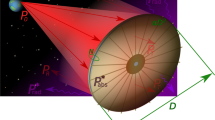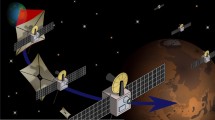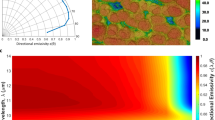Abstract
An abundant source of energy in space, electromagnetic radiation can provide spacecraft with a gentle yet persistent thrust for interplanetary and interstellar missions. Early successes with microlaser and solar propulsion platforms confirm their potential for near-Earth and deep space exploration, although practical realization of reliable photonic devices is not trivial. This Perspective outlines the recent achievements and future outlook in the field of photonic space propulsion. We highlight several light-enabled mechanisms of thrust generation via photon–matter interactions such as photonic pressure and ablation, optical gradient forces, light-induced electron emission and others. Finally, we outline some of the key challenges in the area and possible solutions for practical applications.
This is a preview of subscription content, access via your institution
Access options
Access Nature and 54 other Nature Portfolio journals
Get Nature+, our best-value online-access subscription
$29.99 / 30 days
cancel any time
Subscribe to this journal
Receive 12 print issues and online access
$209.00 per year
only $17.42 per issue
Buy this article
- Purchase on Springer Link
- Instant access to full article PDF
Prices may be subject to local taxes which are calculated during checkout



Similar content being viewed by others
References
Kantrowitz, A. Propulsion to orbit by ground-based laser. Aeronaut. Astronaut. 10, 74–76 (1972).
Nakano, M., Ishikawa, T. & Wakabayashi, R. Laser propulsion technology on KKS-1 microsatellite. Rev. Laser Eng. 39, 34–40 (2011).
Levchenko, I., Bazaka, K., Keidar, M., Xu, S. & Fang, J. Hierarchical multi-component inorganic metamaterials: intrinsically driven self-assembly at nanoscale. Adv. Mater. 30, 1702226 (2018).
Zypries, B. Space, the public, and politics. Space Policy 41, 73–74 (2017).
Kishi, N. Management analysis for the space industry. Space Policy 39–40, 1–6 (2017).
Takenaka, H. Satellite-to-ground quantum-limited communication using a 50-kg-class microsatellite. Nat. Photon. 11, 502–508 (2017).
Levchenko, I. et al. Recent progress and perspectives of space electric propulsion systems based on smart nanomaterials. Nat. Commun. 9, 879 (2018).
Iridium. Follow 8 Launch Missions https://www.iridiumnext.com (2017).
OneWeb Satellites http://onewebsatellites.com (2017).
NASA. New Horizons; https://www.nasa.gov/newhorizons
NASA. New Horizons: NASA’s Mission to Pluto and the Kuiper Belt; www.pluto.jhuapl.edu
NASA. OSIRIS-Rex; https://www.nasa.gov/osiris-rex
Keller, L. P. et al. Infrared spectroscopy of comet 81P/Wild 2 samples returned by stardust. Science 314, 1728–1731 (2006).
Strange, N. et. al. High power solar electric propulsion and the Asteroid Redirect Robotic Mission (ARRM). In IEEE Aerospace Conf. 1–10 (IEEE, 2017).
Takahashi, T., Mitsuda, K. & Kunieda, H. The NeXT Mission. Proc. SPIE 6266, 62660D (2006).
NASA. Mars Today: Robotic Exploration www.nasa.gov/mars (2017).
LoKeidarng, K. F. Deep Space Propulsion: A Roadmap to Interstellar Flight (Springer, New York, 2012).
Levchenko, I. et al. Space micropropulsion systems for Cubesats and small satellites: from proximate targets to furthermost frontiers. Appl. Phys. Rev. 5, 011104 (2018).
LGarde Inc. Sunjammer; http://www.lgarde.com/space-propulsion.php
Biddy, C. & Svitek, T. LightSail-1 solar sail design and qualification. In Proc. 41st Aerosp. Mechan. Symp. 451–463 (2012).
Anderson, J. D. et al. Indication, from Pioneer 10/11, Galileo, and Ulysses data, of an apparent anomalous, weak, long-range acceleration. Phys. Rev. Lett. 81, 2858–2861 (1998).
Turyshev, S. G. et al. Support for the thermal origin of the pioneer anomaly. Phys. Rev. Lett. 108, 241101 (2012).
NASA. Kepler's Second Light: How K2 Will Work https://www.nasa.gov/kepler/keplers-second-light-how-k2-will-work (2013).
Johnson, L. et al. NanoSail-D: a solar sail demonstration mission. Acta Astronaut. 68, 571–575 (2011).
Mazouffre, S. Electric propulsion for satellites and spacecraft: established technologies and novel approaches. Plasma Sources Sci. Technol. 25, 033002 (2016).
Charles, C. Plasmas for spacecraft propulsion. J. Phys. D 42, 163001 (2009).
Choueiri, E. Y. New dawn for electric rockets. Sci. Am. 300, 58–65 (2009).
Aljunid, S. A. et al. Atomic response in the near-field of nanostructured plasmonic metamaterial. Nano Lett. 16, 3137–3141 (2016).
Syring, C. & Herdrich, G. Jet extraction modes of inertial electrostatic confinement devices for electric propulsion applications. Vacuum 136, 177–183 (2017).
Reichhardt, T. Setting sail for history. Nature 433, 678–679 (2005).
Johnson, L., Young, R., Montgomery, E. & Alhorn, D. Status of solar sail technology within NASA. Adv. Space Res. 48, 1687–1694 (2011).
Perlmutter, S. et al. Supernova cosmology project collaboration. Astrophys. J. 517, 565–587 (1999).
Tsuda, Y. et al. Flight status of IKAROS deep space solar sail demonstrator. Acta Astronaut. 69, 833–840 (2011).
Lappas, V. et al. CubeSail: a low cost CubeSat based solar sail demonstration mission. Adv. Space Res. 48, 1890–1901 (2011).
NASA. NASA’s Nanosail-D ‘Sails’ Home—Mission Complete ; https://www.nasa.gov/mission_pages/smallsats/nanosaild.html
Macdonald, M. et al. GeoSail: an elegant solar sail demonstration mission. J. Spacecraft Rockets 44, 784–796 (2007).
Metzger, R. A. & Landis, G. Multi-bounce laser-based sails. AIP Conf. Proc. 552, 397–402 (2001).
Breakthrough Initiatives. Breakthrough Starshot project; http://breakthroughinitiatives.org
Phipps, C. et al. Laser-ablation propulsion. J. Propul. Power 26, 609–637 (2010).
Myrabo, L. N. World record flights of beam-riding rocket lightcraft—demonstration of “disruptive” propulsion technology. 37th Joint Propulsion Conference Paper AIAA01-3798 (2001).
Bergstue, G., Fork, R. & Reardon, P. An advanced optical system for laser ablation propulsion in space. Acta Astronaut. 96, 97–105 (2014).
Eckel, H.-A., Scharring, S., Karg, S., Illg, C. & Peter, J. Overview of laser ablation micropropulsion research activities at DLR Stuttgart. In Conf. Proc. Teilnehmer-CD HPLA/BEP 2014 (2014); http://elib.dlr.de/89091
Sinko, J. Review of CO2 laser ablation propulsion with polyoxymethylene. Int. J. Aerospace Innovations 3, 93–130 (2011).
Phipps, C. R., Luke, J. R., Helgeson, W. & Johnson, R. A ns-pulse laser microthruster. AIP Conf. Proc. 830, 235–246 (2006).
Phipps, C. R. Performance test results for the laser-powered microthruster. AIP Conf. Proc. 830, 224–234 (2006).
Phipps, C. et al. A review of laser ablation propulsion. AIP Conf. Proc. 1278, 710–722 (2010).
Palmer, A. J. et al. Monoenergetic proton beams accelerated by a radiation pressure driven shock. Phys. Rev. Lett. 106, 014801 (2011).
Palmer, C. A. J. et al. Rayleigh-Taylor instability of an ultrathin foil accelerated by the radiation pressure of an intense laser. Phys. Rev. Lett. 108, 225002 (2012).
Merali, Z. Shooting for a star. Science 352, 1040–1041 (2016).
Macchi, A., Borghesi, M. & Passoni, M. Ion acceleration by superintense laser-plasma interaction. Rev. Mod. Phys. 85, 751–793 (2013).
Daido, H., Nishiuchi, M. & Pirozhkov, A. S. Review of laser-driven ion sources and their applications. Rep. Prog. Phys. 75, 056401 (2012).
Zhang, T. et al. Macroscopic and direct light propulsion of bulk graphene material. Nat. Photon. 9, 471–477 (2015).
Corde, S. et al. Observation of longitudinal and transverse self-injections in laser-plasma accelerators. Nature Commun. 4, 1501 (2013).
Clark, L. Graphene spacecraft could fly on starlight. WIRED http://www.wired.co.uk/article/graphene-spacecraft (29 May 2015).
Wu, L., Zhang, Y., Lei, Y. & Reese, J. M. Do thermal effects cause the propulsion of bulk graphene material? Nat. Photon. 10, 139 (2016).
Zhang, T. et al. Reply to ‘Do thermal effects cause the propulsion of bulk graphene material?’. Nat. Photon. 10, 139–141 (2016).
Glückstad, J. Optical manipulation: sculpting the object. Nat. Photon. 5, 7–8 (2011).
Swartzlander, G. A., Peterson, T. J., Artusio-Glimpse, A. B. & Raisanen, A. D. Stable optical lift. Nat. Photon. 5, 48–51 (2011).
Overton, G. Refractive object generates stable optical lift. Laser Focus World 47, 25–26 (2011).
Kaku, M. Optical lift may allow us to steer solar sail spacecrafts and nano devices http://bigthink.com/dr-kakus-universe/optical-lift-may-allow-us-to-steer-solar-sail-spacecrafts-and-nano-devices (7 December 2010).
Grier, D. G. A revolution in optical manipulation. Nature 424, 810–816 (2003).
Serey, X., Mandal, S. & Erickson, D. Comparison of silicon photonic crystal resonator designs for optical trapping of nanomaterials. Nanotechnology 21, 305202 (2010).
Mitchem, L. & Reid, J. P. Optical manipulation and characterisation of aerosol particles using a single-beam gradient force optical trap. Chem. Soc. Rev. 37, 756–769 (2008).
Optical tweezers—Invented by Arthur Ashkin http://www.edubilla.com/invention/optical-tweezers (accessed July 2018).
Ashkin, A. Forces of a single-beam gradient laser trap on a dielectric sphere in the ray optics regime. Biophys. J. 61, 569–582 (1992).
Andrews, D. L. & Bradshaw, D. S. in Optical Nanomanipulation 9-1–9-7 (Morgan & Claypool Publishers, San Rafael, 2016).
Jonas, A. & Zemanek, P. Light at work: the use of optical forces for particle manipulation, sorting, and analysis. Electrophoresis 29, 4813–4851 (2008).
A light touch. Nat. Photon. 5, 315 (2011).
Smith, B. E. et al. Singlet-oxygen generation from individual semiconducting and metallic nanostructures during near-infrared laser trapping. ACS Photon. 2, 559–564 (2015).
Matloff, G. L. The speed limit for graphene interstellar photon sails. JBIS 66, 377–380 (2013).
Rovey, J. L., Friz, P. D., Hu, C., Glascock, M. S. & Yang, X. Plasmonic force space propulsion. J. Spacecraft Rockets 52, 1163–1168 (2015).
England, R. J. Review of laser-driven photonic structure-based particle acceleration. IEEE J. Sel. Top. Quant. Electron. 22, 4401007 (2016).
Bar-Lev, D. & Scheuer, J. Plasmonic metasurface for efficient ultrashort pulse laser-driven particle acceleration. Phy. Rev. ST Accel. Beams 17, 121302 (2014).
Pukniel, A., Coverstone, V., Burton, R. & Carroll, D. The dynamics and control of the CubeSail mission: a solar sailing demonstration. Adv. Space Res. 48, 1902–1910 (2011).
Johnson, L., Swartzlander, G. A. & Artusio-Glimpse, A. In Advances in Solar Sailing (ed. Macdonald, M.) 15–23 (Springer-Verlag, Berlin, 2014).
Tsuda, Y. et al. Achievement of IKAROS—Japanese deep space solar sail demonstration mission. Acta Astronaut. 82, 183–188 (2013).
Bae, Y. K. Photonic laser propulsion: proof-of-concept demonstration. J. Spacecraft Rockets 45, 153–155 (2008).
Bae, Y. K. in New Frontiers in Space Propulsion (ed. Musha, T.) Ch. 4, 103–132 (Nova Science Publishers, New York, 2015).
Popov, S. A., Batrakov, A. V., Kanonykhin, A. V. & Mataibaev, V. Hybrid plasma source based simultaneously on laser ablation and vacuum arc discharge for plasma propulsion. In XXVI Int. Symp. on Discharges and Electrical Insulation in Vacuum 729–732 (2014).
Katsurayama, H., Komurasaki, K. & Arakawa, Y. A preliminary study of pulse-laser powered orbital launcher. Acta Astronaut. 65, 1032–1041 (2009).
Zhang, Y., Zhang, D., Wu, J., He, Z. & Zhang, H. A novel laser ablation plasma thruster with electromagnetic acceleration. Acta Astronaut. 127, 438–447 (2016).
Gilster, P. JAXA sail to Jupiter’s trojan asteroids. Centauri Dreams https://www.centauri-dreams.org/2017/03/15/jaxa-sail-to-jupiters-trojan-asteroids (15 March 2017).
Myrabo, L. N., Messitt, D. G. & Mead, F. B. Ground and flight tests of a laser propelled vehicle. In 36th AIAA Aerospace Sci. Meeting Exhibit Paper AIAA98-1001 (1998).
Roder, P. B. Quantitative Photothermal Heating and Cooling Measurements of Engineered Nanoparticles in an Optical Trap. PhD thesis, Univ. of Washington (2015).
White, H. et al. Measurement of impulsive thrust from a closed radio-frequency cavity in vacuum. J. Propul. Power 33, 830–841 (2017).
Lemmer, K. Propulsion for CubeSats. Acta Astronaut. 134, 231–243 (2017).
Herdrich, G. et al. Research and development on electric and advanced propulsion at IRS. In 35th Int. Electric Prop. Conf. (IEPC) Paper IEPC-2017-480 (Electric Rocket Propulsion Society, 2017).
Sutton, G. P. & Biblarz, O. Rocket Propulsion Elements. 8th edn, (J. Wiley & Sons, Hoboken, 2010; 40.
Fasoulas, S., Herdrich, G., Schateikis, T. & Martin, J. High precision attitude control system based on the emission of electromagnetic radiation. In 35th Int. Electric Prop. Conf. (IEPC) Paper IEPC-2017-273 (Electric Rocket Propulsion Society, 2017).
Acknowledgements
The work was supported in part by the Office for Space Technology and Industry—Space Research Program (OSTIn-SRP/EDB), National Research Foundation, Singapore. I.L. acknowledges the support from the School of Chemistry, Physics and Mechanical Engineering, Science and Engineering Faculty, Queensland University of Technology.
Author information
Authors and Affiliations
Corresponding author
Ethics declarations
Competing interests
The authors declare no competing interests.
Additional information
Additional information
Reprints and permissions information is available at www.nature.com/reprints.
Correspondence should be addressed to I.L.
Publisher's note: Springer Nature remains neutral with regard to jurisdictional claims in published maps and institutional affiliations.
Rights and permissions
About this article
Cite this article
Levchenko, I., Bazaka, K., Mazouffre, S. et al. Prospects and physical mechanisms for photonic space propulsion. Nature Photon 12, 649–657 (2018). https://doi.org/10.1038/s41566-018-0280-7
Received:
Accepted:
Published:
Issue Date:
DOI: https://doi.org/10.1038/s41566-018-0280-7
This article is cited by
-
Interstellar photovoltaics
Scientific Reports (2023)
-
Swarm of lightsail nanosatellites for Solar System exploration
Scientific Reports (2023)
-
Light-driven dandelion-inspired microfliers
Nature Communications (2023)
-
Multilayers for directed energy accelerated lightsails
Communications Materials (2022)
-
Mutually guided light and particle beam propagation
Scientific Reports (2022)



